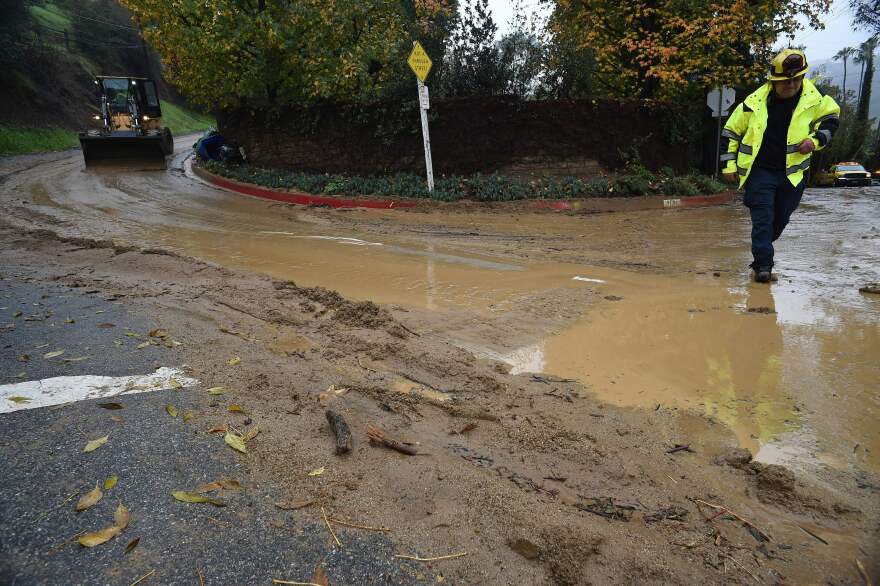Southern California has been experiencing some extreme weather in recent years. We're doing our best to make sense of terms and guidance that can be confusing in already stressful moments.
Last year, as the deadly Fairview fire led to mass evacuations, exacerbated by extreme heat, I explained what the different (and often confusing) evacuation terms mean.
Then the approach of Tropical Storm Kay brought a series of flood watches, last September, which drew my attention to another area of confusion.
FLOOD WATCH is in effect until 10pm for mountains & desert areas of Ventura/LA Counties. Heavy downpours could create rapid flooding and recent burn scars could see mud and debris flows. Stay alert to warnings and do not drive into water. Turn Around Don't Drown. #CAwx #LArain pic.twitter.com/UkPgNWI0AM
— NWS Los Angeles (@NWSLosAngeles) September 12, 2022
Now, with Tropical Storm Hilary bearing down on Southern California, we're once again hearing from people who say it's all very hard to follow.
And guess what? Flood terms have their own alphabet soup. Flood warnings, watches and advisories all come from the National Weather Service (NWS) with a specific coverage area and timespan. Let’s dig into what those categories mean.
-
Listen: Internet costs, ELAC arts program, more
-
More money to fund college campaigns
-
LAX plans to rename terminals and gates
What does a flood warning mean?
A flood warning is issued when a hazardous weather event is imminent or already happening.
If you’re in an area that’s under this warning, especially an area prone to flooding, you need to get to higher ground as soon as possible.
What about flash flood warnings?
Yes, flash flood warnings are slightly different. They’re issued when a flash flood is coming or in progress, according to the NWS.
Flash floods are sudden and violent floods that can start within minutes.
If you’re in an area that’s likely to flood, you need to grab your belongings and move uphill fast.
Even if your area isn’t getting rained on, you’re not in the clear. Flash floods can still rush downhill from other areas with little notice.
Flash Flood Warning including Santa Clarita CA, Lancaster CA and Palmdale CA until 6:30 PM PDT pic.twitter.com/6mlkQ1Ht8e
— NWS Los Angeles (@NWSLosAngeles) August 20, 2023
For the avid weather follower, NWS announcements follow a specific format to convey flash flood information. Here’s what it includes:
- Hazard type: The specific type of event.
- Source information: How the weather event was determined (e.g. radar, emergency managers, gauges).
- Impact potential: The risks that could happen. For example, a flash flood could be life-threatening and widespread.
- Tags: How extreme the damage could be, how it was identified and any other events connected to the flood (e.g. rainfall or dam issues).
If all this sounds like a lot, that’s ok. Local news outlets, like KPCC/LAist, will keep you informed with what you need to know.
In short, remember that flash flood warnings mean you need to move.

How about flood watches?
Flood watches are a step down from warnings.
These are your indicators to get prepared to move. Remember, flooding can happen quickly, so the last thing you want is to be trying to gather your belongings as water is rising.
The NWS issues these watches when weather conditions are prime to support a flood. There’s a chance it won’t happen, but it’s still possible.
So what are flood advisories (and do they matter?)
Yes! Flood advisories are how the NWS begins to raise the alarm. The goal is to give people enough time to take action.
Staying on top of weather changes could mean the difference between life and death.
Flood advisories are issued when the weather could become a “nuisance,” according to the NWS. These notices come when flooding isn’t expected to be as bad to warrant a warning, but situations can always change.
That “nuisance” term is not like personal annoyances — it’s more like inconveniences to the public. The National Oceanic and Atmospheric Administration, which oversees the NWS, says that nuisance flooding is “minor tidal flooding” that can lead to frequent road closures and overwhelmed stormwater systems.
During an advisory, you should stay cautious and drive safely.










